Estimated reading time: 17 minutes
As Food Shortages Continue to Occur, More and More People are Planting Gardens. Here’s How to Make the Most of It.
If a toilet paper shortage wasn’t enough, we’re starting to see curious shortages of eggs, milk, and now meats. It stands to reason that vegetables and fruit may be impacted, especially when you consider how much we depend on produce imports from countries also affected by the coronavirus.
Want to save this post for later? Click Here to Pin It On Pinterest!
Think “Victory Garden”
During World War II, people planted victory gardens to compensate for the lack of available produce. As a result, small gardens sprung up everywhere from cities to suburbs. It was during that time that creative and innovative ways were developed to maximize the yield from any and every garden.
We’re going to cover a few of those ideas, and feel free to share your best ideas in the comments section. We’re also going to assume you live in a temperate zone that has 4 seasons as opposed to far southern zones that have multiple growing seasons.
Thinking Outside the Box
Our standard image of a vegetable garden is defined by rows of vegetables neatly aligned. That’s actually a good idea, and we’re going to do that. But we’re also going to add a dimension or dimensions both up and out. Think of it as multi-level gardening.
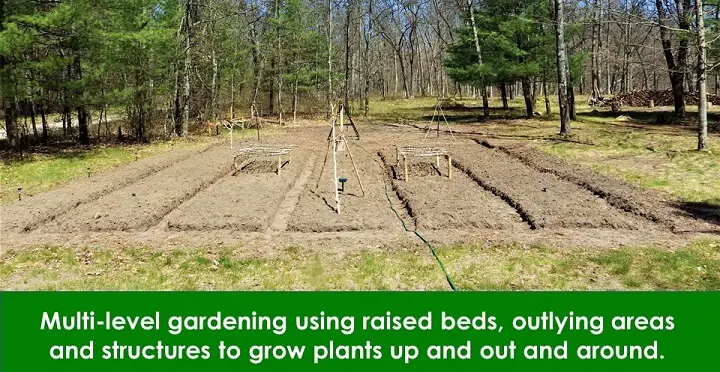
Then again, there’s more to maximizing yield than finding or creating space. Proper soil prep, composting, watering, and some obscure concepts like companion-planting and succession planting also come into play.
As a starter, here are 14 ideas to keep in mind as you continue to plan and plant your garden.
1. Composting
It’s not hard to feed vegetables in a garden with store-bought plant food. The stuff works great, so if you can afford it on a regular basis, go ahead and feed away.
A good, natural alternative is compost. A dedicated compost heap can give you a continual supply of natural nutrients from composted weeds, vegetable scraps, leaves, manure, and yard trimmings.
A sprinkle of pelletized lime or wood ashes over the top will aid the composting process and add a bit of alkalinity to the acidity of composted leaves, pine needles, and other organic materials.

Once you have a good bed of compost, work it into the soil or top it before you rototill.
2. Rototilling
All plants thrive in soft, pliable worked soil. This is especially important for root vegetables that can actually bulge up and out of the ground if the soil is too hard.
Rototilling is the easiest solution, and tilled soil not only gives all roots room to grow but allows both water and nutrients to more easily percolate down to the roots.
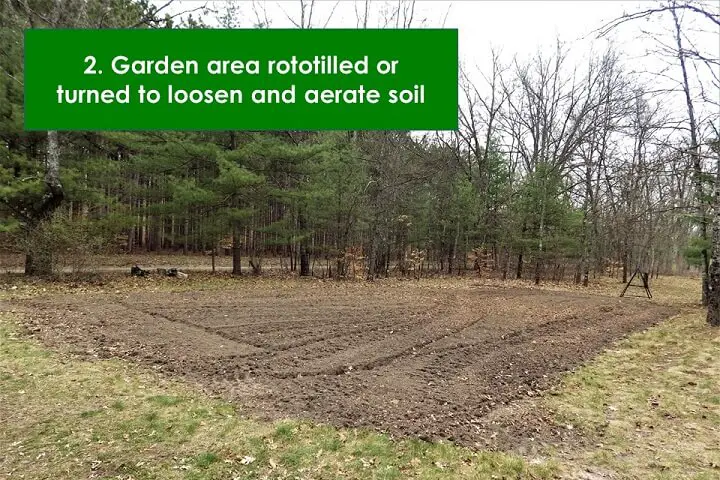
Before tilling, take the time to sprinkle some compost or at least some organic material like leaves or grass trimmings over the area you intend to till. If you don’t have a rototiller, a spading fork or even a shovel will do. Just take your time and do as much as you can over a period of days.
If you do top your soil with leaves or grass clippings, it helps to sprinkle some pelletized lime over the top before tilling. That’ll help any organics to break down more quickly.
3. Raised Beds

The standard approach to raised beds is to nail large 2″ x 10” boards into rectangular boxes and fill them with tilled soil. That’s fine if you can afford the wood and have the soil to spare to fill the boxes, but there’s another way to raise a bed—lower the ground around it.
One of the benefits of this approach is that it allows you to “double-dig” the soil.
You've already tilled ground around you and as you dig trenches around your beds, you shovel the soil up onto the beds to raise them even higher.
The trench gives you a place to walk without trampling your plants and also serves as a bit of a dry moat that can deter moles and voles. Both rodents prefer the protection of soil or mulch over their heads and the minute they burrow out into the open, they usually make a quick U-turn.
It’s not foolproof, but we’ll cover some other natural ways to repel garden pests as we go down the list.
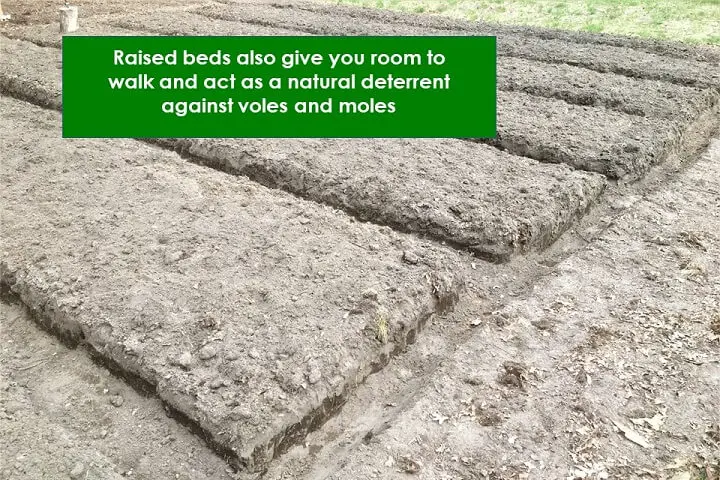
Another benefit of any raised bed is the ability of root vegetables like carrots, turnips, radishes, potatoes, beets, rutabagas, and others to grow to their maximum size.
The bed offers a deep layer of soft, pliable soil that lets large roots expand and grow.
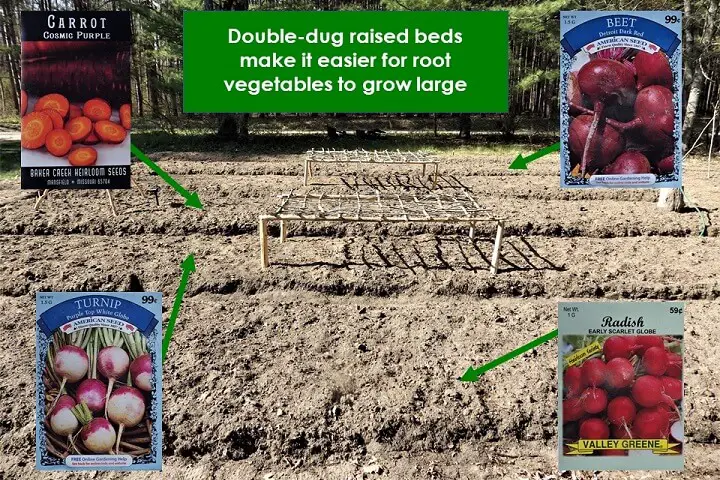
4. From Growing Down to Growing Up
While root vegetables grow down into the ground, many plants like tomatoes, all squash varieties, and even some peppers grow long stems. The standard way to support them is with a tomato cage or stake, but a terraced trellis creates some curious benefits and opportunities.
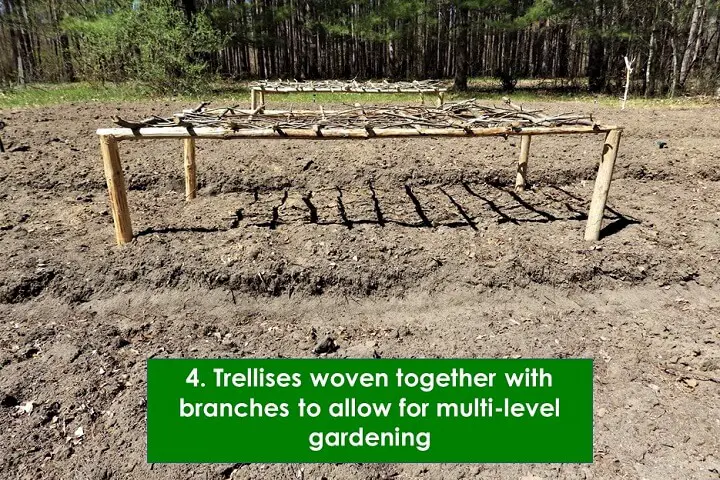
For one, it allows you to grow vegetables like tomatoes on two levels. As one part of the plant grows on the ground and roots any time the stems come in contact with the soil, the other part of the same plant can grow above on the terrace getting full sun.
A latticework of branches also allows the fruits of the tomato or squash plant to grow off the ground up and away from slugs, mice, or other pests that can’t or won’t make the trip to the second story.
5. Companion Planting
A terraced trellis also gives you the opportunity to engage in some companion planting.
It’s been proven that some fruits and vegetables get along quite well in a symbiotic relationship that allows both of them to grow better when planted in close proximity. Tomatoes and onions are a classic companion planted combination and the onions are also known to repel rodents.
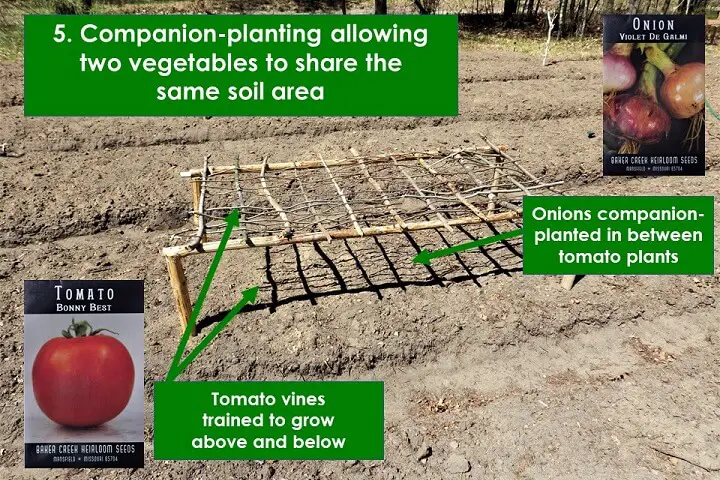
Better yet, the onions can continue to grow long after the tomatoes are harvested basically giving you a double crop from the same section of soil.
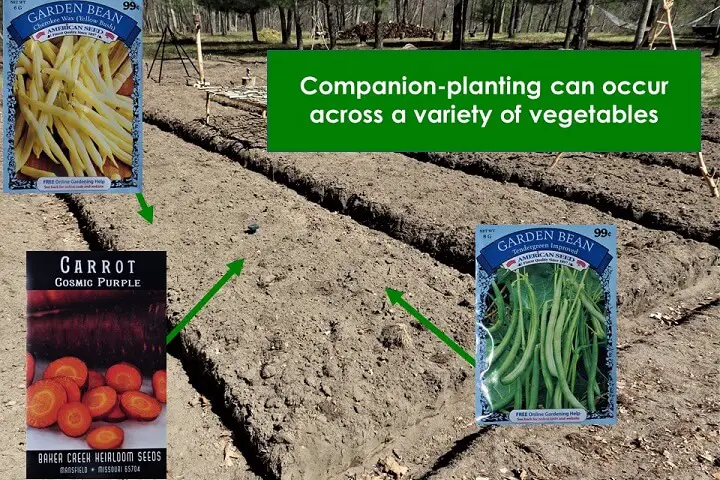
But take note, not all plants get along. The Old Farmer’s Almanac has a listing of plants that make good companions and some that don’t like each other. There’s also advice on which plants repel not only rodents but insects as well.
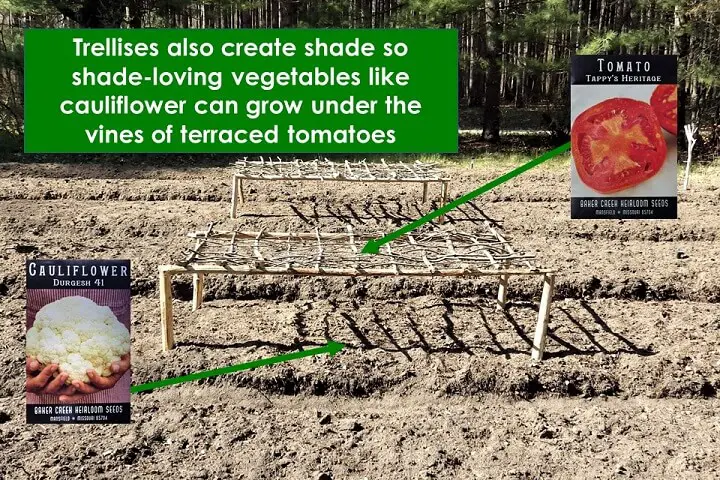
It helps that some shade-loving plants are good companions to tomatoes and squash varieties because the shade of a trellis offers an ideal environment for shade-loving cruciferous vegetables like cauliflower, broccoli, cabbage, kale, and brussels sprouts.
And once again, this combination has an extra benefit. Cruciferous vegetables are highly tolerant of cool weather, including the first frosts, so while they mature in the shade of your tomatoes, they can reach full maturity as the days shorten and the temperatures continue to fall long after the tomatoes are gone—and all in the same patch of soil.
6. Airborne Gardening
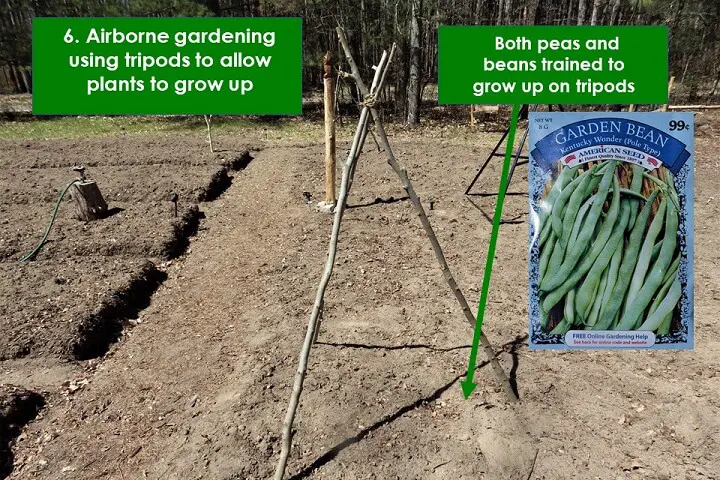
Some vegetables grow on long vines that love to encircle anything they touch. Pole beans are a classic example, but snow peas and others love to find and cling to any upright pole or branch.
A simple way to take advantage of this characteristic is with a basic tripod lashed together from sticks or branches. You can make them as long and tall as you want and most likely will find they’re never tall enough.
By consolidating your long vine vegetables onto your tripods, you again create space underneath for planting any vegetable that’s a compatible companion. And if they happen to be a shade loving vegetable, all the better.
7. Plant Early
Most vegetables come with a “last frost” warning. Don’t plant until all danger of frost is past. But there are exceptions. Peas are one good example and the usual recommendation is that you can plant as soon as you can work the ground. That means you’re past the last, hard freeze.
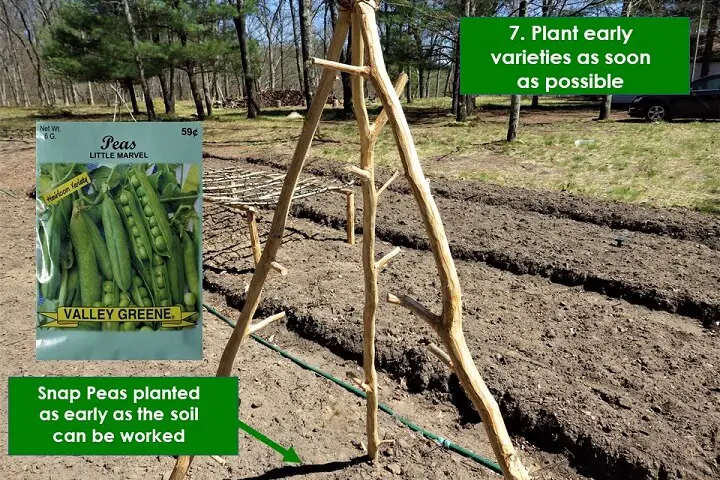
Planting these early birds gives you a head start and, depending on your location, you may even be able to get a second crop.
In fact, the whole idea of timing your garden based on maturation rates is described as succession planting. It’s not about a one and done approach to planting your garden, but continually planting as you harvest.
8. Let Your Ground Vines Travel Far and Wide
Many squash plants like cantaloupe, pumpkin, watermelon, cucumbers, and others tend to have a mind of their own. Their vines meander and, even with constant training and attention, can stray off and wander a bit.
The best solution is to create a large area as a raised bed where the vines can intertwine and grow together.
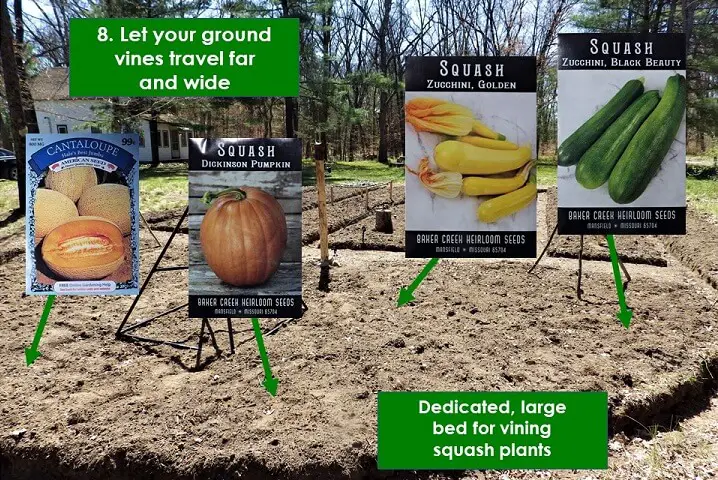
Companion planting in a squash patch is probably not a good idea. The leaves of squash plants tend to be large and prodigious and most other plants growing in their vicinity can’t compete unless they happen to be another squash variety.
The fruits tend to be large and worth the trouble, but the best solution is to let them congregate in a dedicated area and let them fight it out.
9. Make the Most of Every Stake in the Ground
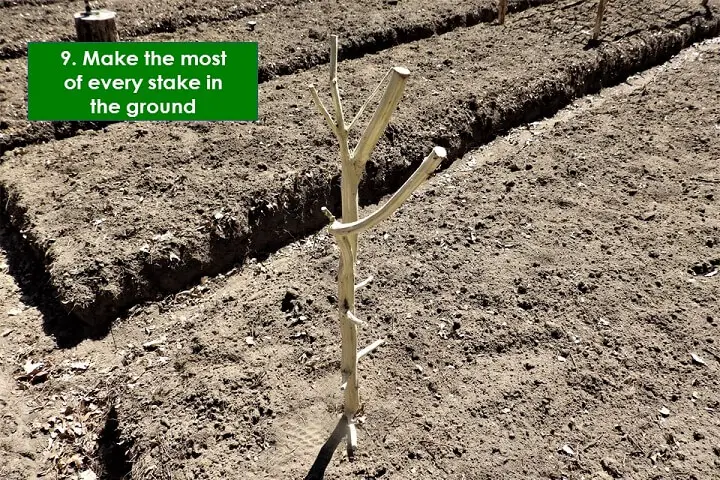
If you buy a garden stake at a garden center, you usually get a straight length of bamboo died green. An easy and free solution is to cut your own stakes and leave some of the branches on the main stem protruding by 3 to 4 inches.
These extra appendages make it easier for a plant to cling to the stake and can even support large fruits and prevent them from causing the main stem to collapse under their weight on a straight, smooth pole.
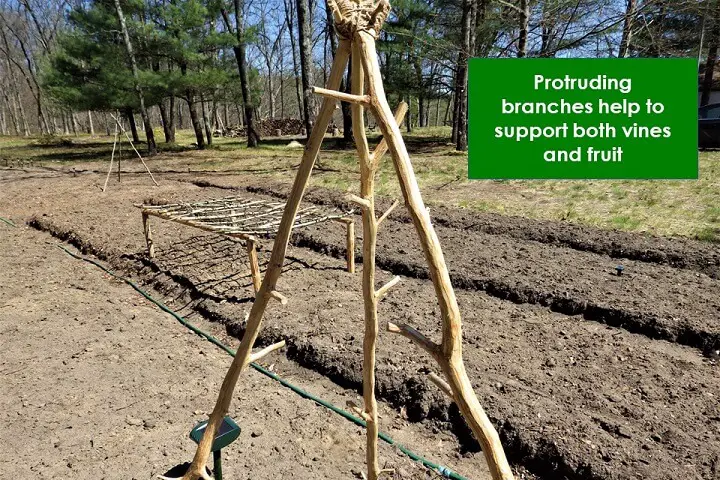
The idea of protruding branches can also work well with a tripod setup. The idea is to give any plant as much support as you can, so you keep them up and off the ground so there’s room to plant more vegetables underneath.
10. Let Your Squash Vines Get Around
Anyone who has ever planted zucchini knows the story. They’re monsters. Their vines are long, their leaves are huge, and the zucchinis can get to be the size of bazookas.
To put it bluntly, they’re garden hogs. Even in a dedicated squash patch, they’re the bullies of the bunch. But there’s a way to tame them. Let them grow where nothing else matters.

Plant your zucchini or any other squash plant that you think might be over-zealous on the fringe of your garden. As the vines mature, train them away from the garden and onto a patchy, grassy area or over mulch.
One healthy zucchini plant could take over an entire bed and, even though the fruits are large, the overall yield isn’t worth the valuable garden soil in your beds that the vines and fruits will cover.
And unlike tomatoes, most stems of squash plants don’t root when in contact with the soil, so there’s little benefit if the vines travel over fertile soil.
11. Flower Beds to Vegetable Beds
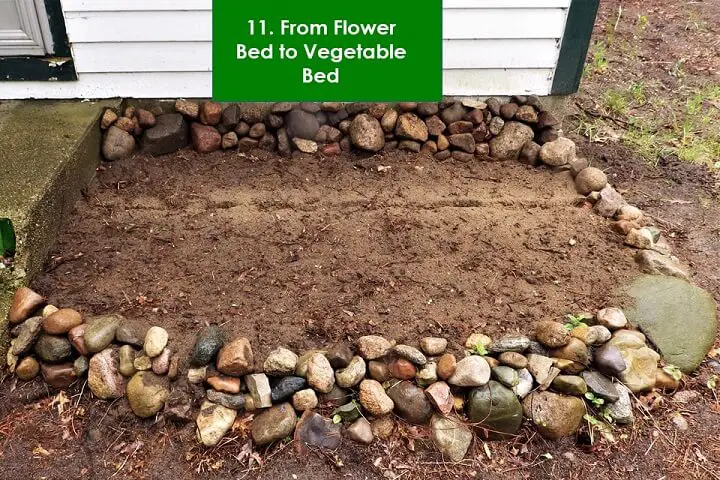
It might be time to think twice about what you plant in your flower beds. It may be a good time to use those beds for vegetables or fruits. Many vegetables are actually ornamental. Kale comes to mind, and herbs from chives to dill to oregano all have flowers at some point in their maturity.
If you’re going for maximum yield in your yard and garden, think about how you might substitute vegetables for flowers. Even onions will eventually flower and are actually members of the allium family along with daffodils and tulips.
But don’t even think about eating daffodil or tulip bulbs. They’re toxic. Stick with the onions.
12. Water, Water, Water
The downside to high-density gardening is that in addition to needing a well-composted soil and maybe an occasional feeding, watering is a regular necessity.
Any garden needs to be watered, and rainfall certainly helps, but when you’re companion planting or growing large squash crops, watering has to be a regular thing.
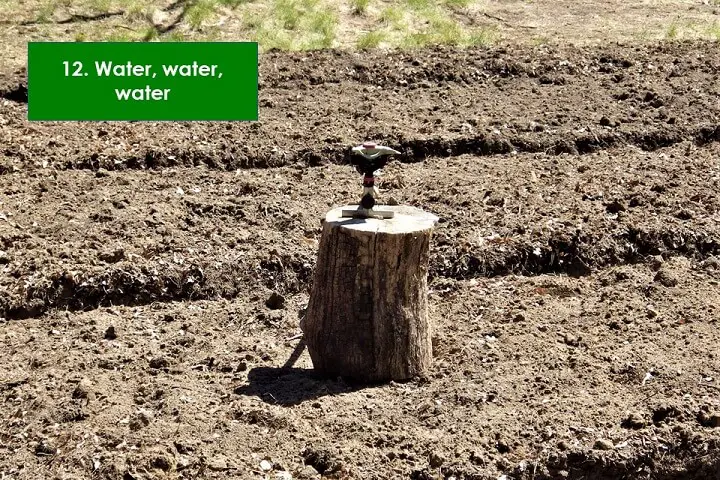
The easiest watering setup is a dedicated sprinkler or two on a stump or post so the water spray can clear the tops of most of the plants. Make sure the water reaches the perimeter of your entire garden.
Mid-morning is the best time to water. Watering in the evening could leave the leaves too damp and over time the cool night air and wet leaves could promote mold growth. You can’t stop it from raining at night, but you can avoid watering at that time.
13. Defend Yourself
Congratulations! You’ve worked hard and have made your garden a veritable banquet for your family and friends… and rabbits and deer and voles and moles and chipmunks and… you get the idea.
There’s nothing worse than walking out to your garden in the morning to see it chopped to pieces by a rabbit still nibbling or an attack of the shrews. It’s time to defend yourself.
The obvious solution is a fence. Many people in urban and suburban homes already have fences in their backyards. They’ll be the first to tell you a fence is no guarantee. In fact, there’s no single solution to garden pests that seems to be foolproof, but you can provide some garden defense in depth.
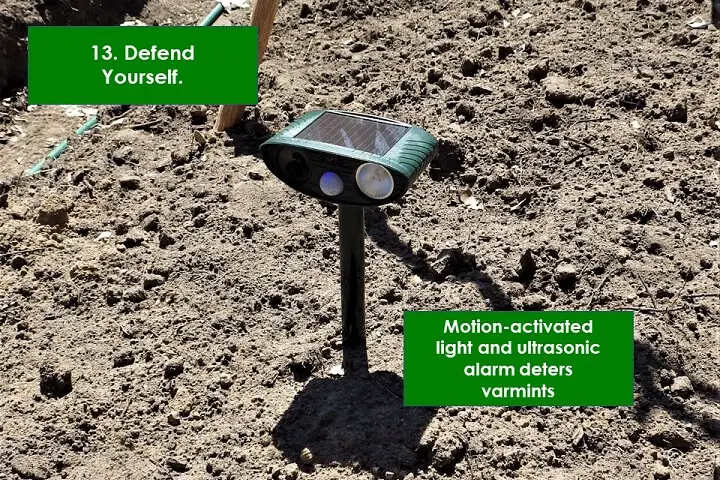
Some of these ideas involve gizmos, usually solar-powered and designed to emit ultrasonic sounds, flash strobe lights or create vibrations that reverberate through the ground.
They all work, at least to varying degrees, but don’t depend on just one. Spread a few around with an eye towards the type of pests you have to deal with and the size of your garden(s).
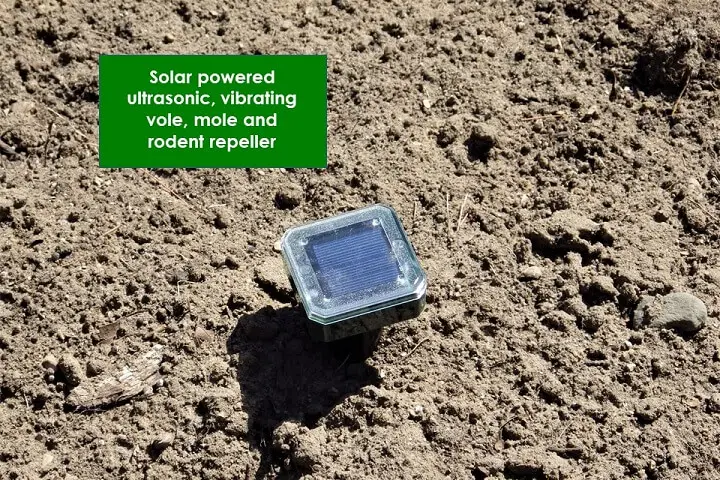
There are other non-chemical or natural solutions as well. An owl perched above your garden will give many rodents pause, and it doesn’t have to be life-like.
As long as the owl in your garden has the iconic pointed ears and large eyes, you’ll fool most rodents. You could even attach a solar light to illuminate your owl at night in case the mice aren’t paying attention.
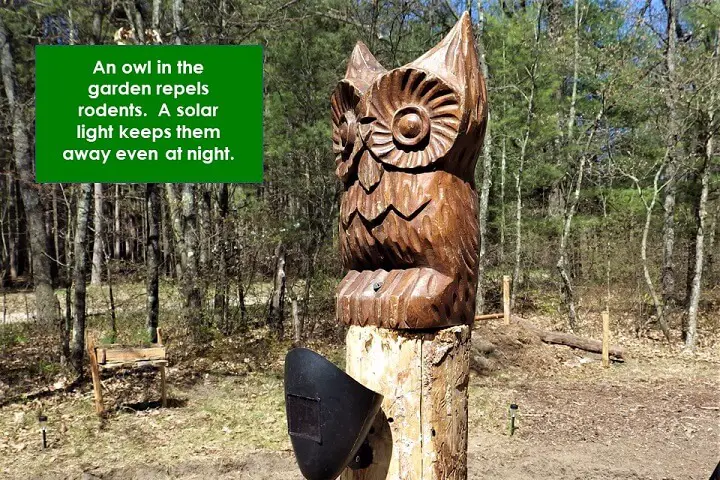
Solar lights around the perimeter of your garden are another option. Most garden pests are nocturnal animals who love the dark and only come out at night. Putting some lights around your garden may encourage them to find a darker place to eat.
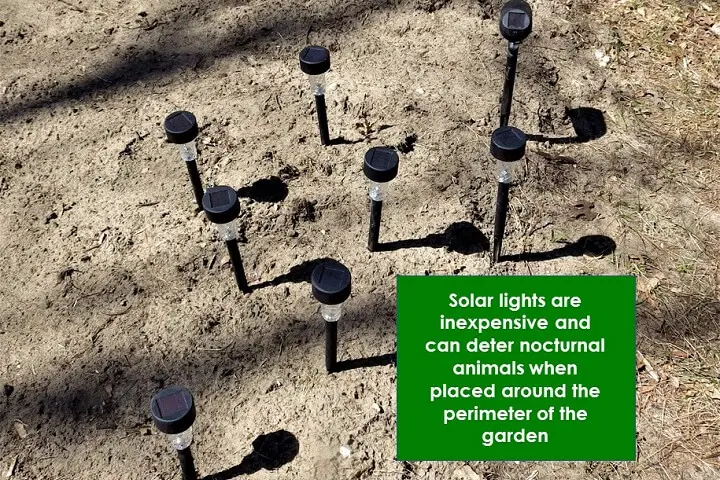
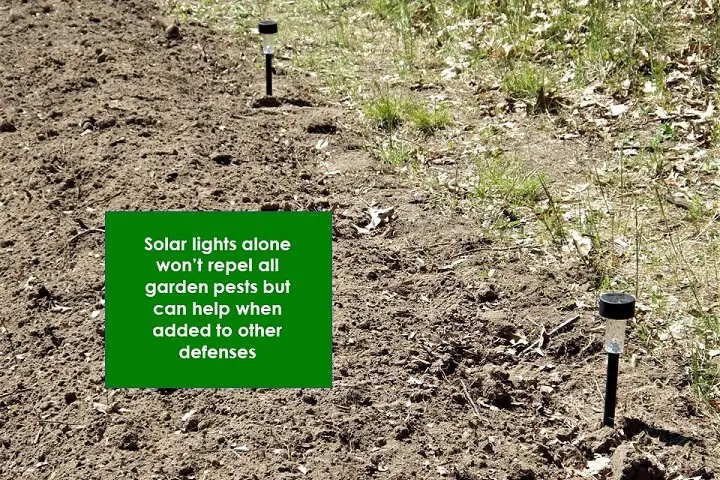
14. But Wait! There’s More
The list of natural ways to repel pests from your garden is long—from coyote urine to coffee grounds and human hair to life-size plastic wolves—but the key concept is to remember that you need to adjust your tactics to the pest and use a combination of methods to get the best results.
The same is true for finding ways to get the best yield from any garden, whether it’s starting as many plants as you can indoors or buying fast-growing hybrid varieties.
For now, the importance of gardening has taken on a whole new meaning and in some ways, many of us may be better off eating our own home-grown fruits and vegetables.
Like this post? Don't Forget to Pin It On Pinterest!


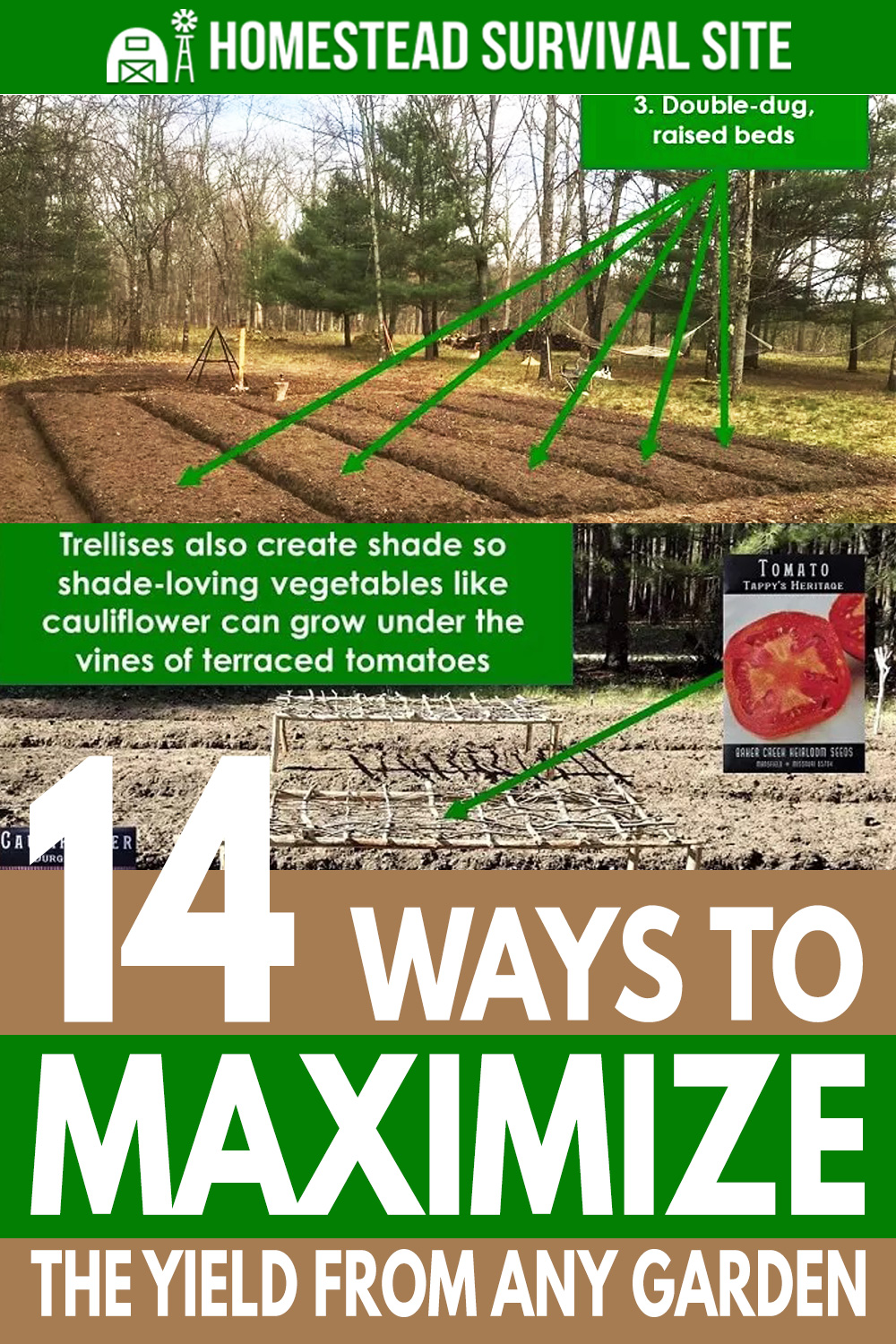
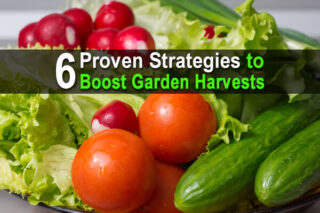
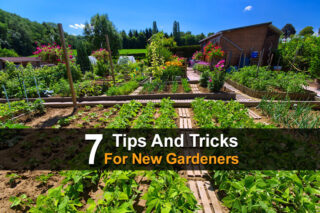

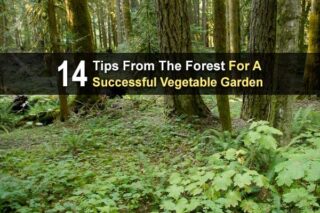
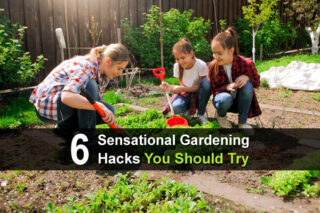
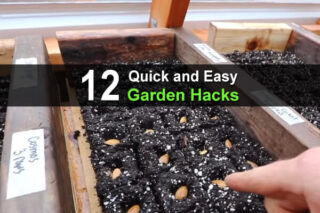

I would not use ANY of the seeds pictured. Unless the dispaly nonGMO right on the front, don’t touch them. and those dollar store seeds have a lower sprout rate any way. If you are putting in your time and effort make sure you get the most out of it